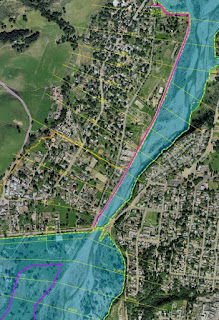 |
| NASA Earth Observatory image by Joshua Stevens, using Landsat data from the U.S. Geological Survey and ASTER GDEM data from NASA/GSFC/METI/ERSDAC/JAROS, and U.S./Japan ASTER Science Team. |
The Thomas Fire burned throughout the month of December, destroying over 1,000 structures and becoming the largest wildfire in California history. The immediate cost escalated over $300 million, plus an undetermined loss of property. Almost 300,000 acres of open space has been transformed, including most of the Ventura River watershed. Although the fire overwhelmed first responders on the night of December 4th, the subsequent mobilization and coordinated response of thousands of firefighters ultimately saved the populated areas of the Ojai Valley.
 |
| WIFIRE Firemap 12-28-2017 |
According to the Ventura River Watershed Plan (Part 2, p75):
• Wild fires can threaten local water quality and supply. Moderate wild fires occur once every 10 years on average, and extreme wild- fires once every 20 years.
– Fifty-four percent of the watershed burned in the 1985 Wheeler Fire.
– Wild fires threaten water supplies largely by causing damaging sedimentation and siltation of reservoirs. Equipment damage, interrupted power supply, ash deposits, and use of water for re suppression are other potential impacts.
The Thomas Fire will undoubtably have a major impact on the Ventura River watershed for the foreseeable future. Increased sedimentation will lead to severe flood risk, and significantly reduce the capacity of Lake Casitas and ability to divert water from the Ventura River at the Robles Diversion.
| Matilija Dam looking upstream following the Thomas Fire, Dec 26, 2017 |
 |
| Hydrology, Hydraulics, and Sediment Studies for the Meiners Oaks and Live Oak Levees |
Meanwhile, it is likely that the next major flood will deliver sediment loads in excess of that expected with dam removal, placing downstream communities at risk. For example, the image here illustrates how the Santa Ana bridge and Live Oak levee in Oak View create a choke point in the river which is likely to back up and overflow with high sediment loads in the river.
The Ventura River Watershed Council will discuss the impacts of the fire:
Thursday, January 4, 2018 / 9-11:30am
Oak View Park and Resource Center Auditorium
555 Mahoney Ave. Oak View, CA 93011
Agenda can be found here.
More info and how to help: https://ovlc.org/thomas-fire-updates/
In the News:
Ojai residents take stock of their blessings — and vulnerability — after surviving the Thomas fire, LA Times Jan 8, 2018
"If substantial rain comes down, I expect sediment and debris to flow over the spillway," said Peter Sheydayi, deputy director at Ventura County Watershed District. "We're in the midst of working on risk reduction measures such as installing debris flow sensors to determine whether evacuations are needed."
"The dam itself," he added, "is safe."
Paul Jenkin, an environmental activist in Ojai and founder of the Matilija Coalition, a nonprofit group dedicated to restoring the Ventura River, is not so sure. Surveying the structure from an overlook and shaking his head in dismay days before the rain, Jenkin said, "Obsolete dams like this one are ticking time bombs."
Officials say there are roughly 8 million cubic yards of debris behind the dam now. "So the next big storm will push huge amounts of mud and water over the top, overwhelming bridges, culverts and roads below," Jenkin said.


